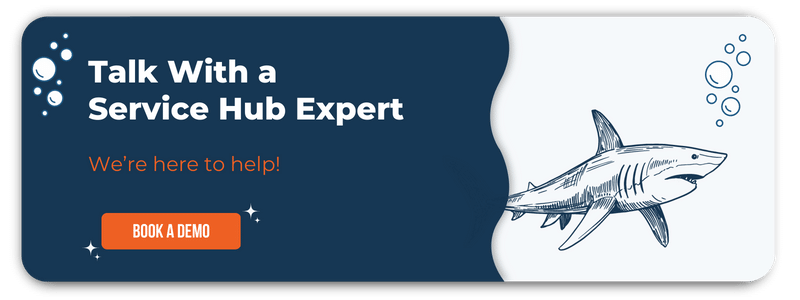Leveraging the HubSpot Services Hub for Customer Feedback
Emily Buchan

If you’ve ever had your beach day rained out, you probably know that even with the best intentions and greatest computer models, we humans are not so great at predicting the future. So when it comes to customer support and satisfaction, it’s best to remove guesswork wherever possible; asking customers about their experiences with your organization will better inform the decisions you make in the near future. If you haven’t already, it’s time to start a customer feedback program.
Why you need customer feedback
Think of your customer feedback program as a doppler radar for your business. We can’t predict future weather with great accuracy. Still, we do have the technology to measure exactly what’s happening right now—and, in the event of severe weather, inform your next move to safety. A customer feedback program does the same: it gives you data on what your customer climate looks like at the moment. That data informs your organization of opportunities to make adjustments and improve customer experience.
In its many forms, customer feedback adds to the conversation between you and your customer base. It’s a space for the customer to say something—and the company to listen. When companies make changes or improvements based on customer feedback, they’re working to retain customers and lower churn rates. Customers stay because they’re happy, and happy customers have the potential to become promoters for your brand, bringing in new prospects.
Additionally, customer feedback can give your organization insight to other problems your customers are having that you could solve. Customer feedback is a way to start anticipating what else your customers want, giving you the opportunity to provide it for them. Results from customer feedback surveys could also inform content creation decisions, giving creators new topics that you know customers want information about.
HubSpot Services Hub: Customer Feedback Spotlight
A great radar shows you the current conditions, lets you track a storm over time, and alerts you when things change. It has all the information in one place and lets you customize it based on your location or what conditions you want to see. The Customer Feedback feature of the HubSpot Services Hub is the radar for all your feedback initiatives. The Customer Feedback tools help you:
- Customize surveys to measure Net Promoter Score (NPS), Customer Effort Score (CES), and customer satisfaction (CSAT) – we’ll talk more about this later.
- Calculate NPS and CES and track changes over time
- Track survey views and responses
- Collect qualitative and quantitative data
- Send surveys by email and over chat
- Offers suggestions to increase response rates
- Analyzes and organizes survey data on the service dashboard
You can use other HubSpot features with the feedback tools, like automating marketing emails based on customer responses or notifying your team when a customer takes a survey.
There are three different survey builders within the feedback tool; each one measures a different aspect of customer happiness:
-
Customer Loyalty: Net Promoter Score (NPS)
-
Customer Support: Customer Effort Score (CES)
-
Customer Experience: Customer Satisfaction Surveys (CSAT)
Customer Loyalty
This survey builder calculates your business’s Net Promoter Score (NPS), a number between -100 and 100 that shows overall customer loyalty based on the answer to one question: On a scale from 0 to 10, how likely are you to recommend (our company/product/service) to your friends or colleagues? A couple of short answer questions follow for the user to explain their response. Think of an NPS survey as measuring the temperature of your company. Obviously, a score of 100 is ideal, but a score over 50 is considered excellent, just like a temperature over 50ºF is ideal for a beach day (although you might still need a light jacket).
HubSpot’s survey builder lets you customize follow-up questions based on users’ initial responses, which allows you to immediately react to how a customer is feeling. Customers who answer 6 or lower might get a question like, “What can we do to improve your experience,” while customers who answer 9 or 10 might be prompted to describe what they find most helpful in the product or service they purchased. Being able to customize the survey allows your business to give a personalized touch to the customer, helping them to feel heard.
Customer Support
This survey builder calculates the Customer Effort Score (CES). This measures how much effort your customers felt they put in to solve their support issue, and it is important to send these surveys as soon as possible after a customer support interaction. But don’t think this will come across as irritating to your customers—the CES survey is only a single question. Customers are prompted to answer, “How easy was it to solve your problem with (our company) today?”. The score is calculated between 1 and 5, an average of responses corresponding to a scale from “very difficult” to “very easy.”
Measuring CES identifies missing pieces in customer support content and strategies and is another measure of customer loyalty. Microsoft’s 2016 State of Global Customer Service Report found that 60% of customers stop working with a business because of a poor service experience. Customer Effort surveys will help your organization identify where the problems are for your customers in your support strategy, and you can make changes to prevent these issues in the future.
While your overall CES is important, placing these surveys in different parts of your support services will help locate weak points. Use CES responses to reinforce and replace the failing support beams of your customer service strategy. Include them at the end of Knowledge Base articles, integrate them into live chat on your website, or send them out with follow-up emails after support phone calls or email interactions. If you’re using your social media as a customer service channel, provide a link to a CES survey in a direct message to a user when the issue has been resolved. HubSpot Customer Feedback surveys can be used on almost any channel.
Customer Experience
If NPS and CES are the linework of a drawing, then Customer Satisfaction surveys (CSAT) are the color. While NPS and CES provide a good framework of customer happiness when it comes to support and loyalty, general satisfaction surveys can get a picture of how customers are feeling at any point in their experience. This short survey simply asks, “How satisfied were you with your experience today?” and allows respondents to give an answer on a scale from 1-5. This type of CSAT can measure a general customer satisfaction score, a percentage from 0 to 100, based on the number of satisfied customers (those responding 4 or 5) over the total number of responses.
Linework and color are great, but what makes a piece of art really pop is some depth and shading. Customer Satisfaction surveys can be more complex and ask qualitative questions to achieve that depth. Consider including multiple choice questions to learn more about your survey respondents and identify if certain demographics or job titles have more struggles with your product or service than others. Also, as in the NPS survey, you can include short answer questions. Hence, customers have an opportunity to convey in their own words how they feel or provide specific instances when they are happy or unhappy. Keep surveys a respectable length. However, long surveys can result in fatigue, where respondents stop halfway through.
Place these surveys where you want to know more about how customers are doing. Send one out in an email after a customer has made a purchase if they don’t reach out to customer support or support content within a certain timeframe. Just because a customer is silent doesn’t mean they’re content—they could be struggling and unsure what to do about it, or maybe they’re ecstatically happy. Either way, you’d want to know, wouldn’t you?
The HubSpot Services Hub makes creating, sending, and tracking surveys easier than ever with its Customer Feedback tools. Find overall results on one dashboard, access the more detailed responses, and get suggestions to improve your survey practices and increase response rates. And, if you’re already using any of HubSpot’s software suite, you don’t have to create another account and remember another password. All of HubSpot’s services are accessible under one login and work together to help you grow your business.


